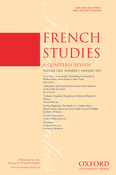-
Views
-
Cite
Cite
Alexandra Tranca, Charles Marville: Photographer of Paris, French Studies, Volume 69, Issue 1, January 2015, Pages 132–133, https://doi.org/10.1093/fs/knu294
Close - Share Icon Share
Extract
Accompanying the Washington National Gallery of Art's ambitious retrospective exhibition centred on the almost thirty-year photographic career of Charles Marville (pseudonym of Charles-François Bossu, 1813–1879), this catalogue offers visual delight and fascinating insights through comprehensive and stimulating essays that complement each other admirably. Curator and editor Sarah Kennel's opening chapter provides an illuminating synthesis of the photographer's life and work: from the revelation of his identity to his education and career as illustrator, and the influence of this on his approach to photography, the chapter foregrounds the creation of a persona — Marville. The photographer's versatility and resourcefulness match his ‘professional aspirations and understanding of the image trade’ (p. 12). The breadth of Marville's contribution to photographic history emerges through his innovations and experiments with subjects and technology alike. Importantly, in her discussion of the treatment of urban space, Kennel corrects the misconception of the photographer's work ‘as part of an official discourse of modernization’ and his image as ‘Haussmann's advance man’ (p. 29), restoring auctorial agency by highlighting Marville's engagement with the city. In the second essay Anne de Mondenard explores the early works, emphasizing Marville's inquisitive, enterprising nature and his penchant for invention through a discussion of the range of experiments he undertook in the photographic medium. Of particular interest is the study of previously unpublished calotypes from the Commission des monuments historiques collection. The degree to which Marville experimented stylistically and conceptually comes through in his transformation of the city into a stage-set (p. 157), and light and shade into structural elements (p. 159). Examining Marville's ‘approach to seriality’, the chapter invites a reappraisal of its role in the history of photography and art (p. 167). Peter Barberie discusses Marville's pioneering dialogue with the landscape genre with reference to his series on the ‘newly renovated bois de Boulogne’: as the ‘first municipal project’ (p. 171), it marks a turning point in his commissions under the Second Empire. Barberie aptly parallels Marville's foregrounding of a different ‘pictorial experience’, which would subsequently define street photography of the 1860s, with how it responds to the hybrid park-landscape, interrogating its relation to ‘old conventions, both social and aesthetic’ (p. 187). Françoise Reynaud's study of the Old Paris series is notable for its focus on the commissioning of the urban photographs. Among the reasons and uses for the corpus, she remarks that the pictures were not ‘designed to illustrate the old city's dilapidated and unsanitary state’ (p. 195). Instead, a conjectural reading reveals their role in remapping Old Paris following the Commune's destruction of the city's topographical surveys. Joke de Wolf then analyses the Universal Exhibitions' relationship with photography, and Marville's role therein. From ideological discourse to reconstruction aids, the photographs showcase not only the city's rebirth but also, ultimately, the 1878 Paris Exhibition itself. High-quality, full-page reproductions, some in colour, and a wealth of other views capture the masterful effects that Marville achieved by using different techniques and supports. The five studies reveal a uniquely complex figure, exploring the stylistic and conceptual implications at stake in Marville's projects, with well-researched contextual information and in-depth readings of form and content.




